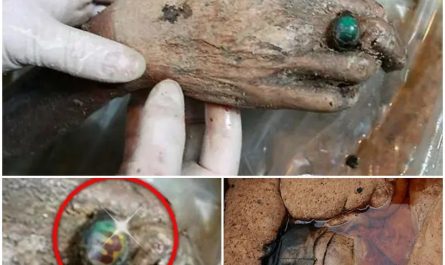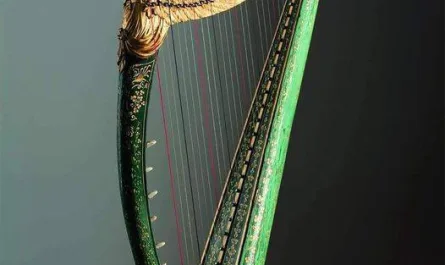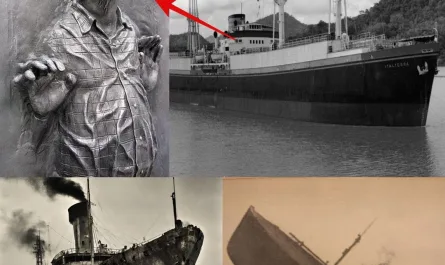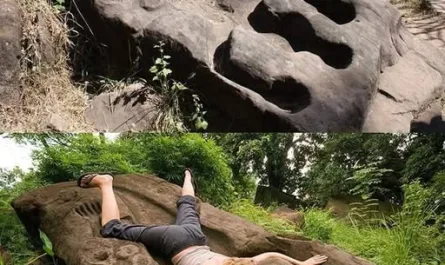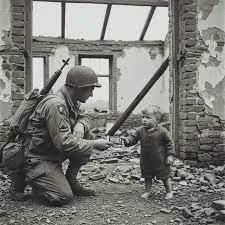
The black-and-white photograph, taken in the summer of 1944 amid the ruins of Normandy, France, captures a moment of profound humanity: an American soldier in full combat gear, helmet tilted back, tenderly holding a little French girl on his lap as she clings to him, her face buried in his shoulder. Surrounded by fellow soldiers and a military dog, the scene unfolds against a backdrop of destruction—a bombed-out farmhouse, rubble-strewn ground, and weary troops. The girl, silent and traumatized beside her dead parents when discovered, reportedly threw her arms around the soldier after he offered chocolate, whispering through tears, “Don’t leave me.” He didn’t. He carried her to safety and, moved by her plight, adopted her after the war. This image, often shared with the caption “My whole life began with a hug on a battlefield,” symbolizes love emerging from war’s darkest hours. Yet, the full story reveals layers of truth, myth, and enduring legacy, reminding us how compassion can transcend conflict.
The Photograph and Its Context
Taken during the Normandy campaign following D-Day (June 6, 1944), the photo likely dates to July–August 1944, as Allied forces liberated villages from Nazi occupation. The soldier, identified in some accounts as Staff Sergeant Richard “Dick” L. Clark of the U.S. Army’s 2nd Infantry Division, was part of the push inland. The girl, estimated at 4–6 years old, was found orphaned in a farmhouse near Saint-Lô or Carentan, her parents killed by artillery or airstrikes. The image, credited to military photographers or soldiers’ personal cameras, circulated in postwar albums and veterans’ memoirs, gaining viral fame in the 2010s on social media with emotional narratives.
The scene’s details—the soldier’s M1 helmet, fatigue jacket, and the girl’s plaid dress—evoke the era’s raw reality. Fellow troops watch with quiet empathy, the dog adding a touch of normalcy amid chaos. The photo’s authenticity is undisputed, preserved in archives like the U.S. Army Signal Corps or private collections.
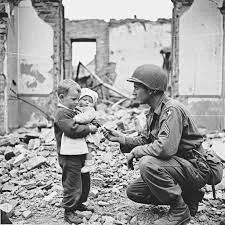
The True Story: Compassion, Not Adoption
While the viral caption claims the soldier adopted the girl, historical verification reveals a different, yet equally moving, truth. The soldier did comfort the child, offering chocolate and carrying her to safety, where she was handed to Red Cross workers or local aid. Adoption by American GIs was rare due to legal barriers and wartime logistics; most orphaned children were placed with relatives or French orphanages. The girl’s identity remains unknown—possibly reunited with family or raised in France—but the soldier’s act of kindness, documented in veterans’ letters, saved her from immediate peril.
The “adoption” element appears to be a later embellishment, blending real compassion with romanticized narratives common in war stories. Similar photos from Normandy, like those of GIs with French children, fueled such tales, emphasizing humanity amid horror. The soldier, if Clark or another, likely returned home without further contact, as many did.

Cultural and Historical Significance
This photograph, like Claude Mellan’s Sudarium or the black cat of Emperor Uda’s diary, captures a fleeting moment of connection. It reflects the Normandy campaign’s human side—over 425,000 casualties, including civilians—where soldiers, far from home, became temporary guardians. The image parallels the Dahomey Amazons’ resilience or Samir and Muhammad’s bond, showing compassion in adversity. In France, it evokes les enfants de la guerre, with thousands orphaned in 1944.
Viral in the 2010s–2020s, it inspired memorials and posts on Veterans Day, symbolizing war’s dual face: destruction and decency. Its misattributed adoption story, like the De Loys ape hoax, highlights how narratives evolve for emotional impact.

Lessons for Today
The photo imparts timeless insights:
- Humanity in Conflict: Like the Frydenbø generator’s innovation, it shows kindness amid crisis.
- Truth in Stories: The embellished adoption, akin to the Eltanin Antenna’s mystery, urges verifying viral tales.
- Compassion’s Legacy: The soldier’s hug, similar to Mohamed Bzeek’s care, reminds us to embrace the vulnerable.
A Hug Through History
In 1944 Normandy, a soldier’s embrace saved a girl from despair, their moment immortalized in a photograph that whispers of love in war’s ruins. Like the precision of Hot Wheels or the mystery of the white auroras, it endures as a beacon of humanity. A fleeting gesture, it echoes eternally: in the darkest times, a hug can begin a life anew.

